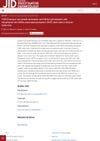Search
for
Sort by
Research
930-960 / 1000+ results
research Diverse Cellular Players Orchestrate Regeneration After Wounding
Different cell types work together to repair skin, and targeting them may improve healing and reduce scarring.
research Regeneration of a Bioengineered 3D Integumentary Organ System from iPS Cells
Scientists created a functional 3D skin system from stem cells that can be transplanted into wounds.
research Long-Term Extensive Ectopic Hair Growth on the Spinal Cord of Mice from Transplanted Whisker Follicles
Transplanted whisker follicles caused long hair growth on the spinal cords of mice.

research Trends in the Global Organoid Technology and Industry: From Organogenesis in a Dish to the Commercialization of Organoids
Organoid technology is advancing and entering commercial use, with applications in disease modeling, drug development, and personalized medicine.
research Male Pattern Hair Loss: Can Developmental Origins Explain the Pattern?
Male pattern hair loss may be linked to the developmental origins of hair follicles.

research Application of Second Near Infrared Fluorescence Imaging to Trace CelTrac1000-Labeled Hair Follicle Epidermal Neural Crest Stem Cells in Repairing Rat Facial Nerve Defects
NIR-II imaging effectively tracked stem cells that helped repair facial nerve defects in rats.

research Hair Restoration Surgery: Challenges and Solutions
Hair restoration surgery effectively treats hair loss with natural-looking results, using techniques like stem cells and platelet-rich plasma.
research Construction of Tissue-Engineered Nerve Conduits Seeded with Neurons Derived from Hair-Follicle Neural Crest Stem Cells
Neurons from hair follicles can help repair damaged nerves.

research Platelet-Rich Plasma for the Management of Hair Loss: Better Alone or in Combination?
PRP is effective for hair loss and might work better with other treatments, but more research is needed.

research Hair Follicle Generation by Injections of Adult Human Follicular Epithelial and Dermal Papilla Cells into Nude Mice
Injecting a mix of human skin and hair cells into mice can grow new hair.
research Synthesis and Biological Screening of Small Molecule Peptides Based on the Amino Acid Sequence of Thymosin Beta 4
Some synthesized peptides improved cell growth better than thymosin β4, VEGF, and minoxidil.

research The Anti-Atopic Lotions Containing Fucoidan Extracted from Ecklonia Cava Impact on Hairless Mice with Atopic Dermatitis
Lotion with fucoidan from brown seaweed improved skin and reduced allergy symptoms in mice with dermatitis.

research Novel Therapies for Alopecia Areata: The Era of Rational Drug Development
New targeted therapies for hair loss from alopecia areata show promise, with personalized treatment expected in the future.

research Severe Metabolic Disorders Coexisting With Werner Syndrome: A Case Report
A patient with Werner syndrome showed a range of aging-like symptoms and metabolic issues, underscoring the need for early detection and treatment.

research Valproate-Associated Transaminitis and Rhabdomyolysis
Valproic acid can cause muscle damage and liver issues, which improve after stopping the drug.

research The Progress in Bioprinting and Its Potential Impact on Health-Related Quality of Life
Bioprinting could greatly improve health outcomes but faces challenges like material choice and ensuring long-term survival of printed tissues.
research Hair Follicle Associated Pluripotent (HAP) Stem Cells from Young Mice Have the Greatest Potential to Differentiate to Cardiac Muscle Cells
Young mice's hair follicle stem cells are best for turning into heart muscle cells.
research Deriving Keratinocyte Progenitor Cells and Keratinocytes from Human-Induced Pluripotent Stem Cells
Scientists developed a way to create skin and hair cells from human stem cells, which could help treat burns and restore hair.
research Highly Efficient Neural Differentiation of CD34-Positive Hair-Follicle-Associated Pluripotent Stem Cells Induced by Retinoic Acid and Serum-Free Medium
Hair follicle stem cells can become nerve cells using specific treatments.

research Extensive Hair Growth Stimulation and Follicle Normalization With Transplanted Hair Follicle Associated Pluripotent Stem Cells in Athymic Nude Mice
Transplanted stem cells from hair follicles significantly boosted hair growth and normalized follicles in certain mice.
research Hair-Follicle-Associated Pluripotent Stem Cells
HAP stem cells can repair nerves and spinal cords by becoming Schwann cells.

research Skin Organoids Derived From NCSTN Mutated Patient-Induced Pluripotent Stem Cells Recapitulate Hidradenitis Suppurativa Pathogenic Hallmarks
Skin organoids with NCSTN mutation show changes in hair follicle development and higher inflammation, key features of Hidradenitis Suppurativa.

research Hair Follicle Regeneration From Human Pluripotent Stem Cells
Scientists have found a way to create hair follicles from human stem cells, which could potentially be used to treat hair loss.

research Stem Cells, Organoids and Their Applications for Human Diseases: Special Issue of BMB Reports in 2023
Organoids created from stem cells are used to model diseases, test drugs, and develop personalized and regenerative medicine.
research Stem Cells and Peripheral Nerve Injury: Potential and Challenges
Stem cells show promise for nerve injury treatment, but more research is needed before human use.

research Characterization of Ectomesenchyme as an Origin of Epidermal Stem Cells
Ectomesenchyme is a key source of skin stem cells.

research Parkinson's Disease and Skin Disorders: Non-Iatrogenic and Iatrogenic Connections
Parkinson's disease is linked to skin disorders and skin cells help in studying the disease.
research CDK9 Kinase Activation in Association with AFF1-SEC Initiates Epidermal Progenitor Differentiation
NCSTN gene mutation causes abnormal skin cell differentiation and more inflammation, contributing to Hidradenitis Suppurativa.

research Stem Cell Identification: In Vivo Lineage Analysis Versus In Vitro Isolation And Clonal Expansion
In vivo lineage labelling is better than in vitro methods for identifying and understanding stem cells.